Are you looking for a ground cover that won’t take over your garden? Check out my list of non-invasive ground covers! These plants are perfect for folks who want to cover soil without working in the garden every other weekend.
Here are 11 ground covers to consider for your garden:
- Fetterbush (Leucothoe axillaris)
- Creeping thyme (Thymus serpyllum)
- Sweet box (Sarcococca confusa)
- Kinnikinnick (Arctostaphylos uva-ursi)
- Bugleweed (Ajuga reptans)
- Allegheny spurge (Pachysandra procumbens)
- Creeping phlox (Phlox stolonifera)
- Brass buttons (Leptinella squalida)
- Barrenwort (Epimedium)
- Himalayan maidenhair (Adiantum venustum)
- Basket of gold (Aurinia saxatilis)
Let’s take a closer look at these plants. Regardless of how your garden looks, one of them is bound to be a good fit.
1. Fetterbush (Leucothoe axillaris)
This heat-tolerant plant is perfect for gardens with shade or partial shade. It features glossy, dark green leaves and bell-shaped white flowers in springtime. It can grow to 6 feet (1.82 meters) tall and three feet (0.91 meters) wide, making it an excellent option for gardeners who want to cover the ground with tall plants.
However, it’s a good idea to avoid planting this one near any short plants in your garden. That’s because fetterbush will be towering over them, cutting their access to space and sunlight. If you’re looking for a more traditional ground-hugging groundcover, choose the compact Leucothoe fontanesiana Scarletta
Fetterbush should be pruned. You should remove stems that grow the wrong way or those damaged by frost. By thinning out old leaves, you will encourage new growth from below-ground rhizomes, which means you will have more plants!
Early spring is the best time to prune your plant. It’s when they’re most dormant and getting ready for new growth.
- Zones: This plant can only be grown in hardiness zones four through eight.
- Light: Partial shade or full sun.
- Watering Needs: Keep the soil moist but not too wet, and do not let it dry out between watering sessions.
- Fertilizing: Fertilize once or twice a year in the spring and fall.
- Pruning: Prune in early spring before new growth begins.
- Size: Up to 3 feet (0.91 meters) wide and 6 feet (1.82 meters) tall.
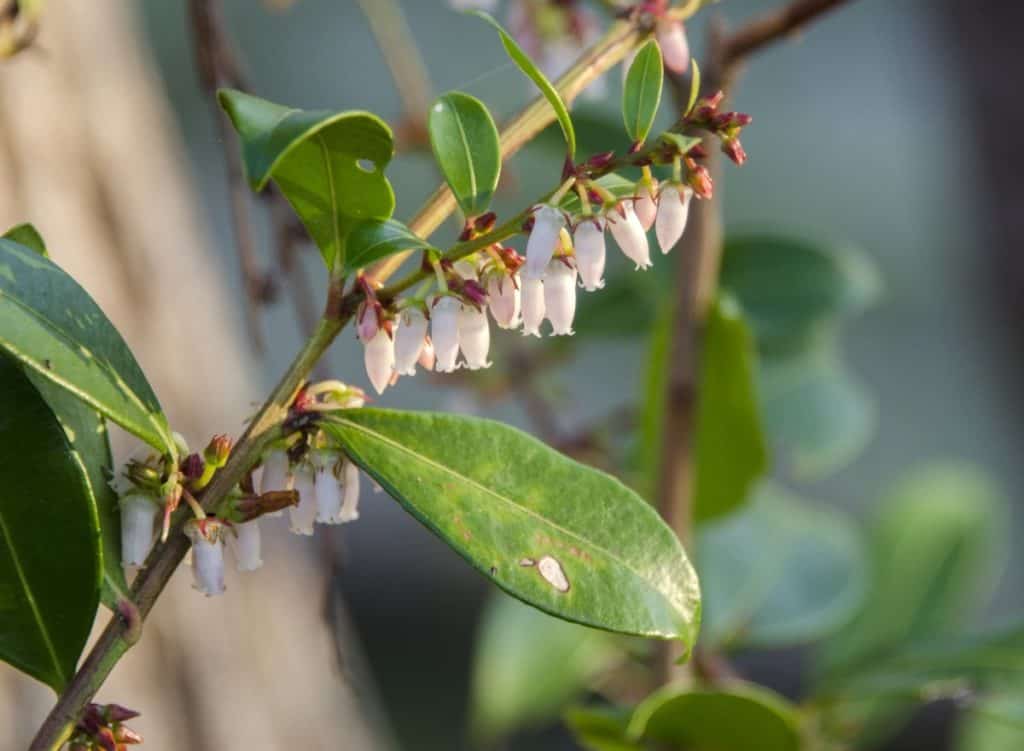
2. Creeping Thyme (Thymus serpyllum)
This fragrant ground cover is a popular choice for gardeners because it’s easy to grow and doesn’t require much maintenance. It has small, gray-green leaves and purple flowers that bloom in the springtime.
Creeping Thyme can be planted in either full sun or partial shade and does well in dry, sandy soils. It’s also drought-tolerant, making it an excellent option for gardeners who live in drier climates.
One of the best things about this ground cover is that it can be used to discourage weed growth, and since it attracts bees and butterflies, it’s perfect for gardeners who want to create a pollinator-friendly garden.
To keep your creeping thyme looking its best, you can trim it back after it’s finished blooming. This will help to keep it from sprawling too much and getting out of control.
- Zones: Creeping thyme can be grown in zones four through nine.
- Light: Full sun or partial shade.
- Watering Needs: Keep the soil moist but not wet, and do not let it dry out between waterings.
- Fertilizing: Fertilize once or twice a year in the spring and fall.
- Pruning: Trim back after blooming to keep your plant from getting out of control.
- Size: 2 to 3 inches (5.08 to 7.62 cm tall.
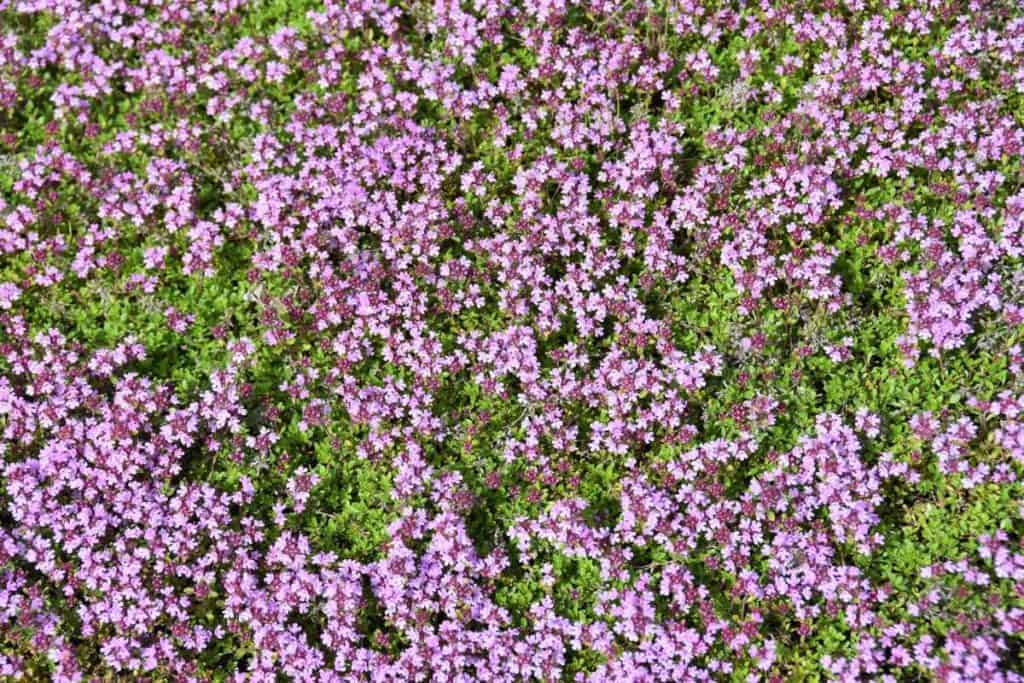
3. Sweet Box (Sarcococca confusa)
This is an excellent option for gardeners who want to keep their ground cover under control. It has glossy green leaves that turn bronze in the fall and winter months, making it perfect for adding some color to your yard.
The sweet box can be planted in either full sun or partial shade and does well when grown along with other plants in your garden. It also attracts butterflies and hummingbirds, making it an excellent choice for pollinator gardens.
The best time to prune sweet boxes is in the spring and summer months after bloom. This will help keep it from getting too large or sprawling out of control. You might also want to consider trimming off any dead or dying branches during these seasons as well.
The sweet box is susceptible to fungal diseases, so be sure to keep an eye out for any signs of infection and treat it as soon as possible. You can also prevent diseases by ensuring your plant has good airflow and isn’t planted too close to other plants.
- Zones: This ground cover can be grown in zones six through nine.
- Light: Full sun or partial shade.
- Watering Needs: It is not too water-hungry. Just make sure to water during the dry season.
- Fertilizing: Fertilize once or twice a year in the spring and fall.
- Pruning: Prune after blooming time in the spring and summer months.
- Size: 10 to 12 inches (25.4 to 30.48 cm) tall.

4. Kinnikinnick (Arctostaphylos uva-ursi)
One kinnikinnick plant can spread up to 15 feet (4.57 meters), and its leaves are medium-sized. It flourishes in organic soils with full sun exposure, so avoid planting it under taller plants.
This ground cover needs fertile, well-draining soil to be healthy. Regular watering is essential, but never make it soggy. When the plant becomes too large for one location, it should be divided into smaller pieces after flowering. This will promote the growth of new plants while containing the size of the original kinnikinnick.
The best time to divide your kinnikinnick is in early spring, before root growth occurs and when the ground has thawed enough for digging. That is usually between May and June, depending on your area’s climate conditions.
Fertilize your Kinnikinnick with a slow-release fertilizer in the spring and summer months to promote blooming. Be sure to not overfeed, since this can cause yellowing leaves or root rot problems later on.
- Zones: This ground cover can be grown in zones two through six.
- Light: Full sun or partial shade.
- Watering Needs: Water during the first few months, then water moderately during the dry season.
- Fertilizing: Fertilize once or twice a year with a slow-release fertilizer in the spring and summer months.
- Pruning: Trim back after flowering time.
- Size: 6 to 12 inches (1.82 to 3.65 cm) tall.

5. Bugleweed (Ajuga reptans)
Ajuga is a genus of flowering plants in the Lamiaceae family, with about 70 species. It is native to North America, Europe, Asia, and Northern Africa.
You can plant ajuga by dividing the plants into clumps and planting the clumps 12 to 18 inches (3.65 to 5.48 cm) apart. Cover the chunks with 2 or 3 inches (0.6 or 0.91 cm) of soil and tamp the ground lightly. Water well and keep the soil moist until the plants are established.
Ajuga is a durable ground cover tolerant of drought, heat, and humidity. It also tolerates light foot traffic and grows well in shaded areas. You can get it in several colors, including blue, green-purple, and burgundy.
If your ajuga is not doing well, you may need to water it more often. You may also need to fertilize it with a low-nitrogen fertilizer and keep the area weed-free.
- Zones: Ajuga can be grown in zones three through nine.
- Light: Partial shade to full sun.
- Watering Needs: 1 inch of water when establishing the plant
- Fertilizing: Fertilize once or twice a year with a low-nitrogen fertilizer.
- Pruning: Trim after flowering time. Prune lightly, if needed, to maintain shape.
- Size: 6 inches (15.24 cm) tall and up to 18 inches (45.72 cm) wide.

6. Allegheny Spurge (Pachysandra procumbens)
Allegheny spurge is a non-invasive ground cover that does not require mowing. The plant will reach a height of 8 to 12 inches (20.32 to 30.48 cm) and a width of 2 to 3 feet (0.6 to 0.91 cm). It has green leaves that are about one inch long. The flowers are small and white, and they bloom in the late spring.
Allegheny spurge grows best in full sun but can also tolerate partial shade. It does well in dry conditions but should be watered sparingly during periods of drought.
The main benefit of this plant is that it is a lovely, well-adapted, and non-invasive ground cover. It is easy to care for and has no serious pests or diseases that affect it. These qualities make it a good choice for areas that are difficult to maintain, such as steep slopes or shady areas.
- Zone: Allegheny Spurge can be grown in zones five through nine.
- Light: Partial shade to full sun.
- Watering Needs: 0.8 cups of water per nine days.
- Fertilizing: Fertilize once or twice a year with a low-nitrogen fertilizer.
- Pruning: Trim after flowering time. Prune lightly, if needed, to maintain shape.
- Size: 8 to 12 inches tall (20.32 to 30.48 cm).

7. Creeping Phlox (Phlox stolonifera)
Creeping phlox is another non-invasive ground cover. It has long, slender stems with needle-like leaves and small pink or white flowers. The plant reaches an average height of 6 to 12 inches (15.24 to 30.48 cm) tall and spreads by runners or stolons that creep along the soil surface.
Creeping phlox grows in various soil conditions and does best when planted in the spring or fall. It is a good choice for rock gardens, slopes, and other hard-to-maintain areas because it requires little maintenance once established.
For propagation, you can divide the plants during spring or fall. Dig up the whole clump and cut off large chunks with a knife, leaving no more than two inches of stem on each one. Remove all dead flowers and leaves from the plant before dividing it.
Blooming time for creeping phlox is typically in the spring, but it can also bloom in the summer.
- Zone: Creeping Phlox can be grown in zones three through nine.
- Light: Partial shade to full sun.
- Watering Needs: Keep the soil moist but not wet, and let the ground be somewhat dry between watering sessions.
- Fertilizing: Use compost, peat moss, or manure once or twice a year.
- Pruning: Trim as needed to maintain shape. Do not prune in late fall or winter.
- Size: 6 to 12 inches (15.24 to 30.48 cm) tall and up to 18 inches (45.72 cm) wide.
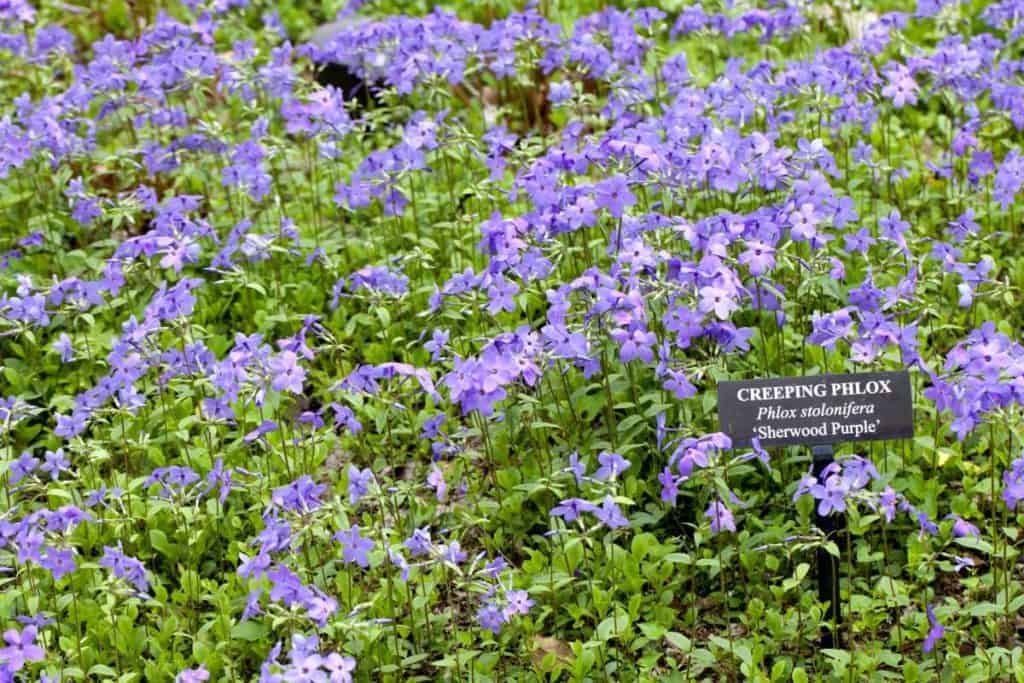
8. Brass Buttons (Leptinella squalida)
Brass buttons is a plant with yellow flowers that blooms from late winter to early spring. The leaves are evergreen, up to 2 inches (5.08 cm) long, and lance-shaped. It grows in clumps and spreads by underground rhizomes.
This ground cover prefers full sun but will tolerate partial shade. The soil should be moist but well-drained. Water regularly, especially during periods of drought, and fertilize with a slow-release fertilizer in early spring. Prune as needed to maintain shape.
Brass buttons are sometimes viewed as invasive but their spread is quite low (the California Invasive Plant Council Inventory rating is “limited”). It can be used in areas where other ground cover plants will not grow.
To clean this plant, you can use a hose or a sprinkler. Just be careful not to damage the leaves or flowers. You can also gently pull off dead flowers and trim away any brown or damaged leaves. You will need to do this regularly, especially during periods of drought.
- Zone: Brass buttons can be grown in zones five through nine.
- Light: Full shade to partial sun.
- Watering Needs: Keep the soil damp for best plant health and color.
- Fertilizing: Fertilize once a year with a slow-release fertilizer.
- Pruning: Trim as needed to maintain shape. Do not prune in late fall or winter.
- Size: 2 inches (5.08 cm) tall and 18 inches (45.72 cm) wide.

9. Barrenwort (Epimedium)
Barrenwort is an evergreen ground cover that blooms from late winter to early spring. It has small, purple flowers, and it grows in clumps.
Taking care of this plant is easy. It can tolerate full shade and partial sun, but it prefers dappled or light shade, and you should water the soil well when transplanting Barrenwort.
This ground cover is an excellent choice for large areas with dense foliage, but it can be aggressive and should not be planted near other plants or in small spaces.
This plant has no serious pest or disease problems, and it can be propagated by division in the spring.
- Zone: Barrenwort can be grown in zones five through eight.
- Light: Full shade to partial sun.
- Watering Needs: Keep the soil moist but not wet, and do not let it dry out between watering sessions.
- Fertilizing: Fertilize in the spring.
- Pruning: Trim as needed to maintain shape. Do not prune in late fall or winter.
- Size: 6 to 8 inches (15.24 to 20.32 cm).
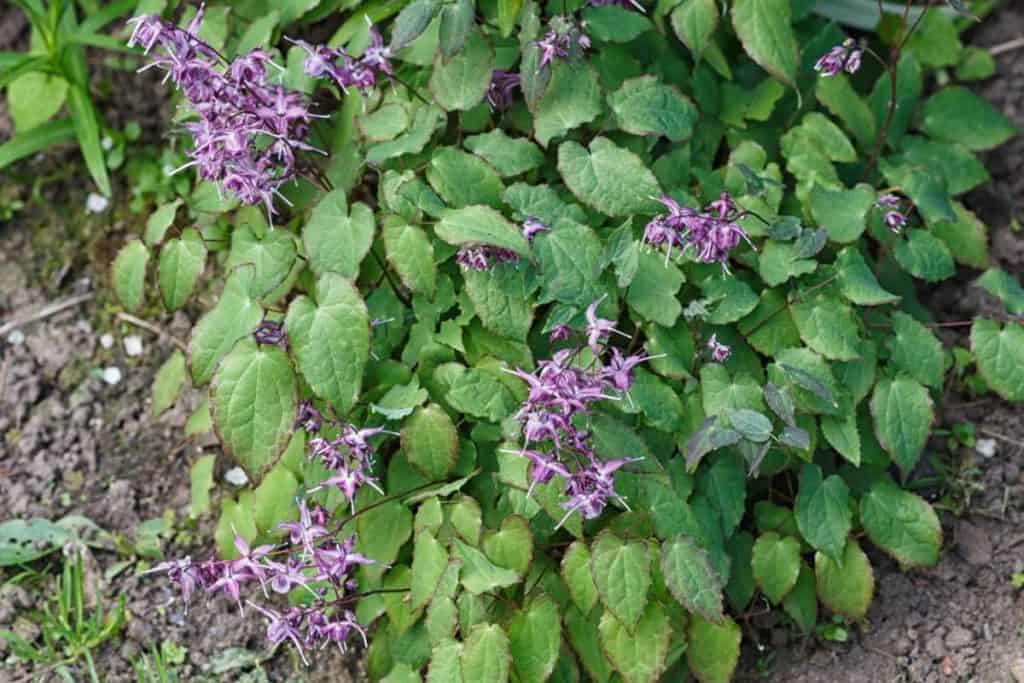
10. Himalayan Maidenhair (Adiantum venustum)
The Himalayan maidenhair is an evergreen ground cover that has no flowers. Its leaves are small and delicate, and they can be grown indoors or outdoors.
Regular watering is essential for this plant, especially during times of drought. Fertilize twice a year with a balanced product for best results.
Pruning this plant is easy. You just need to trim back any dead or damaged leaves and stems in late fall or early winter.
Himalayan maidenhair is a good choice for covering large areas with dense foliage, but it can be aggressive and should not be planted near other plants or in small spaces.
- Zone: Himalayan maidenhair can be grown in zones five through eight.
- Light: Full shade to partial sun
- Watering Needs: Keep the soil moist but not wet, and do not let it dry out between watering sessions.
- Fertilizing: Fertilize once or twice a year with composted manure. Do not use inorganic fertilizers.
- Pruning: Trim as needed to maintain shape. Do not prune in late fall or winter.
- Size: 6 to 8 inches (15.24 to 20.32 cm) tall.
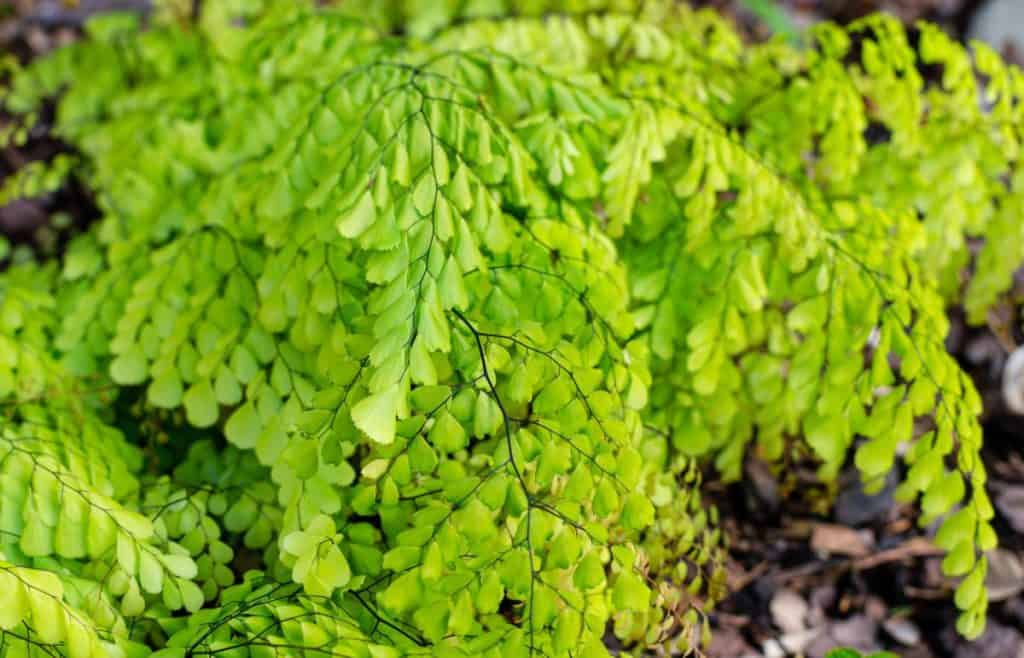
11. Basket of Gold (Aurinia saxatilis)
You can plant this bright yellow cover plant in spring. It is a fast-spreading perennial, making it perfect for covering large areas.
It can easily grow to be about 12 inches (30.48 cm) tall and spreads out quickly without cutting back the foliage. Don’t use this ground cover in an area with small children—the plant can be toxic if ingested.
This ground cover is great for soil erosion control as it has a deep-rooting system that holds in place very well. You will want to make sure you leave this ground cover alone after planting. Otherwise, it might get disturbed and new plants will start popping up all over your yard.
- Zone: Basket of gold grows in zones 3 through 7.
- Light: Plant in full sun to part shade.
- Watering needs: Keep evenly moist.
- Fertilizing: Apply a balanced fertilizer in spring.
- Pruning: Cut back the foliage after bloom and divide every few years.
- Size: Grows 12 – 18 inches (30.48 – 45.72 cm) tall and spreads quickly.


